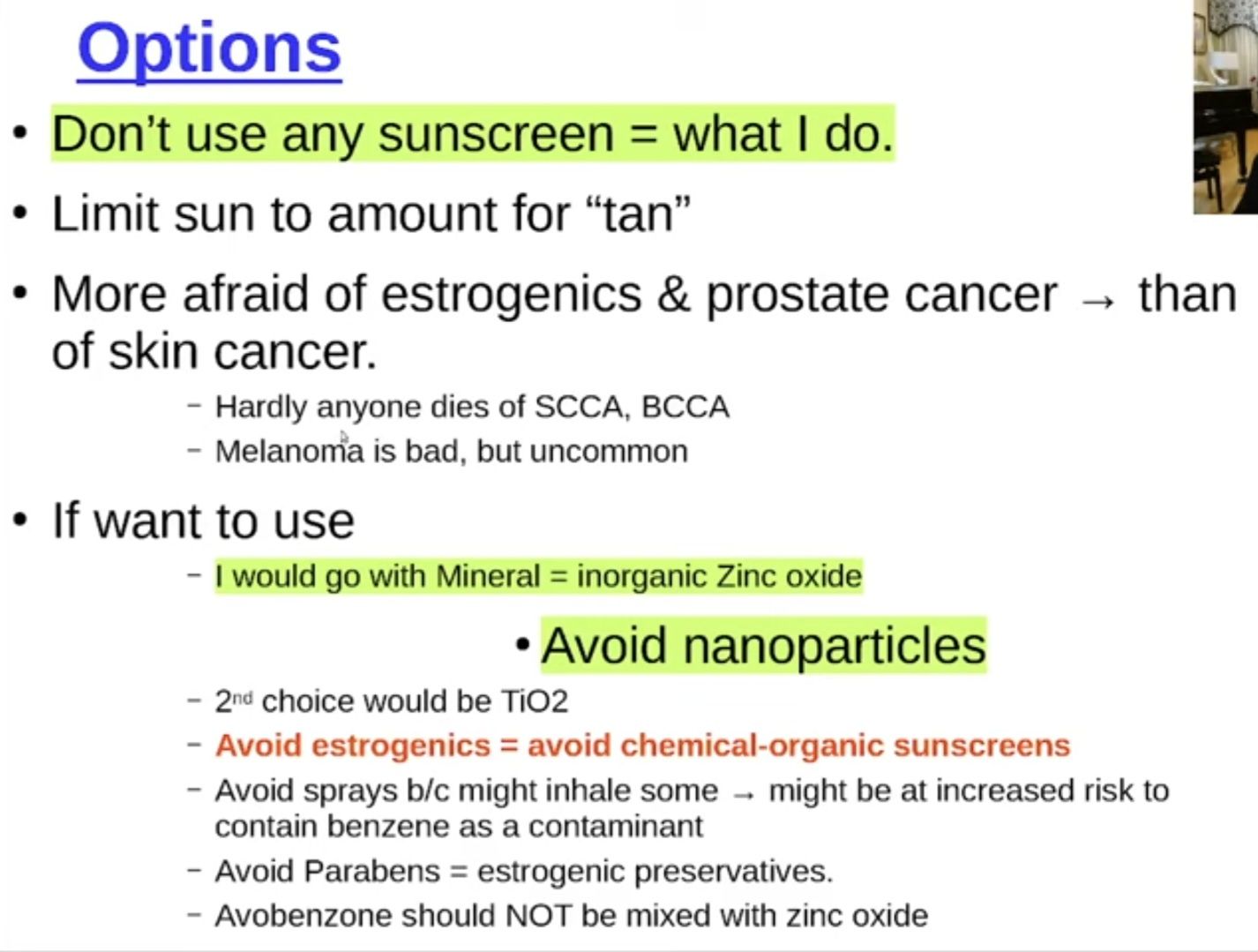
Sunscreen often has estrogenic chemicals & nanoparticles. I avoid it. Barrier clothing can block the sun. If you have to wear sunscreen, because work outside in the sun, the video explains best options.
Full video (for summary advance to time 15:30)

Sunscreen often has estrogenic chemicals & nanoparticles. I avoid it. Barrier clothing can block the sun. If you have to wear sunscreen, because work outside in the sun, the video explains best options.
Full video (for summary advance to time 15:30)
The History of Psychiatry & Big Pharma, From Bleeding, Electroconvulsive Therapy, Asylums, Freud, Chemical Lobotomies & More.
In an honest ride through the history of psychiatry, from blood letting, induced epilepsy, electroshock therapy, lobotomies and other discarded “cures”, to the latest “preferred” drugs of the day. Manufacturing Madness takes a deep look into the snake pit.
Who is insane, what causes mental illness and how should it be treated? Why are approximately 22 US veterans committing suicide each day? Why has the number of disabled mentally ill in the United States tripled in the last two decades? Why have hundreds of thousands of people have died, as a result of using pharmaceutical drugs.
Manufacturing Madness looks at the moral implications of the medical industrial complex, the pharmaceutical industry, drug reps, medical schools, the journals, the media, the absence of real medical science, and the lack of oversight by our captured regulatory agencies, private insurance firms and lobbying influence upon our corrupted legislators.
Medicine is becoming problematic, as it claims undisputed control over the lives of the people of this world. Is psychiatry the new religion, as it seeks absolute compliance and decision-making power, over our bodies and souls?
Manufacturing Madness should be required viewing for anyone who has used, is using or considering psychiatric medicine.
The film features many of the world’s most vital voices concerning the actions and practices of psychotherapy: Peter Berrigen; PhD, Peter Gotzsche; Col. Bart Billings, PhD; Kelly Brogan, MD; Ken Castleman, PhD; Jim Gottstein, Esq.; Henry Grayson, PhD; Patrick Hahn, PhD; Andrew Harvey; Robert F. Kennedy Jr.; JD, Mario Martinez, PhD; Toby Watson Run Time: 2 Hrs 5 mins
Ingredients:
For the Tofu:
1 block of super firm tofu, thinly sliced or shredded
EVOO spray
1/4 tsp turmeric powder
1⁄2 tsp garlic powder
1⁄4 tsp paprika
1/4 tsp kala namak (AKA Indian black salt)
Freshly cracked black pepper
1 tbsp tahini
2 tbsp nutritional yeast
1⁄2 cup soy milk
For the Sweet Potato:
1 large sweet potato, sliced thinly (or shredded)
A pinch of salt
1⁄2 tsp smoked paprika
Cashew Chipotle Queso:
3/4 cup raw cashews
2 tbsp nutritional yeast
1⁄4 tsp salt (optional)
1⁄8 tsp garlic powder
1⁄4 tsp cumin
1/4 tsp paprika
1/2 of a chipotle pepper in adobo sauce
1/2 cup boiling hot water and few tbsp more (as needed) to make the queso thinner
April 2024
April 2024
He wrote:
PLEASE FORGIVE ME
1. In light of the recent news about Pfizer, a weakness in the industry, which I am part of, has been revealed.
2. I feel saddened because, before meeting Dr. Razin Jaafar, there were many mistakes in the medical advice I provided, especially concerning COVID.
3. However, I am very grateful to him because I am now more open-eyed and more enlightened about health sciences, which honestly are more natural and fitting to my soul as a medical practitioner and as a Muslim.
4. During the past COVID times, it cannot be denied that it was difficult for health care workers who strived to provide the best health services, and even more difficult for the rest of the citizens facing the lockdown.
5. The administration of the vaccine at that time was seen as the best way, and the mass vaccination program was launched very quickly.
6. I was also involved, in my capacity, in giving medical advice and obtaining ‘consent’ so that the vaccine could be administered.
7. I, as a medical practitioner, also received 3 Pfizer vaccines.
8. Everything happened in a ‘touch & go’ manner, it was impossible for me to identify whom I had given medical advice related to this issue.
9. With this, I would like to apologize a thousand times for the mistakes I had made in the previous years, especially to those who came to me during the mass COVID-vaccination season.
10. Honestly, I am incapable of assisting financially should complications occur.
11. However, I will try my best to provide more holistic medical advice, in line with the Restorative sciences brought by Dr. Razin.
I apologize, Malaysian Citizens!
Dr. Syafiq Nordin Restorative Medicine
https://vigilantnews.com/post/malaysian-doctor-apologizes-for-pushing-covid-death-shots/
April 19, 2024
The mRNA COVID-19 shots “should be completely banned! If they’re going to be used for anything, it has to be what they are, gene therapies,” says renowned oncologist and professor Angus Dalgleish, known for his research in cancer and HIV/AIDS.
https://vigilantnews.com/post/cancer-doctor-issues-urgent-warning/
April 3, 2024 (video is 1.5 hours long)
March 30, 2024 (video is over 2 hrs long, but worth the time invested)
Bret Speaks with Ryan Cole about his role as a Covid dissident over the last 4 years, and his unique viewpoint as a pathologist. Find Ryan Cole on X: @drcole12 ( / drcole12 ) *****
PS Read comments below this video on youtube for an interesting post-interview story posted by Cole’s sibling.